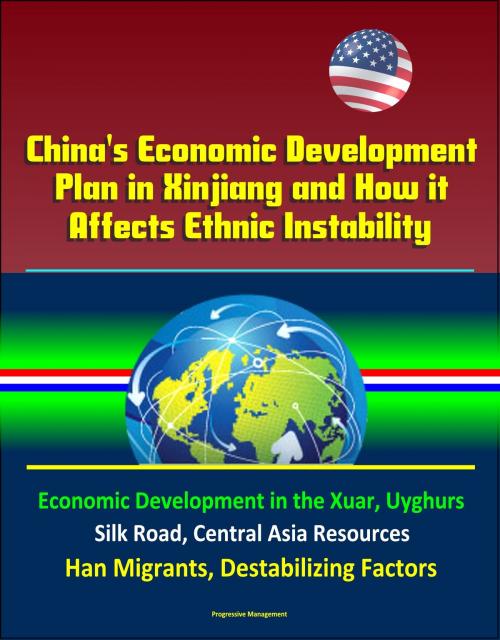China's Economic Development Plan in Xinjiang and How it Affects Ethnic Instability: Economic Development in the Xuar, Uyghurs, Silk Road, Central Asia Resources, Han Migrants, Destabilizing Factors
Nonfiction, Social & Cultural Studies, Political Science, Government, Communism & Socialism, History, Asian, China| Author: | Progressive Management | ISBN: | 9781370412556 |
| Publisher: | Progressive Management | Publication: | November 29, 2016 |
| Imprint: | Smashwords Edition | Language: | English |
| Author: | Progressive Management |
| ISBN: | 9781370412556 |
| Publisher: | Progressive Management |
| Publication: | November 29, 2016 |
| Imprint: | Smashwords Edition |
| Language: | English |
This excellent report has been professionally converted for accurate flowing-text e-book format reproduction. To decrease ethnic instability in Xinjiang, the Chinese government's plan is to economically develop the region. Xinjiang is rich in natural resources, is geographically significant and has a special economic zone. China is also investing in Central Asia to further meet its energy demand. A network of pipelines and major rail systems connect sources from China to Central Asia and beyond. Xinjiang's economy will benefit from the network because it is the gateway and corridor to Central Asia and a hub for the Silk Road traffic. This study suggests that Xinjiang's economic development led to a few destabilizing elements, including Han migration, income disparity and employment discrimination. All of this is taking place while the government is also dealing with other cultural issues, such as religion and education. The author hypothesizes that China's economic development plan in the Xinjiang Uyghur (or Uighur) Autonomous Region increases, decreases or is a subsidiary factor to ethnic instability. This paper argues that China's economic development plan for Xinjiang affects ethnic stability in Xinjiang as a subsidiary factor.
CHAPTER I - INTRODUCTION * A. BACKGROUND OF XINJIANG * 1. Demography * 2. Geography * 3. Resources * 4. History * 5. Religion * 6. Conflict * B. LITERATURE REVIEW * CHAPTER II - CHINA'S ECONOMIC DEVELOPMENT PLAN IN THE XUAR * A. RESOURCES * B. INVESTING FOR FUTURE GROWTH: SILK ROAD * C. SPECIAL ECONOMIC ZONE * D. DEVELOPMENT BEYOND CHINA'S BORDERS * 1. Xinjiang: The Gateway and Land Bridge to Foreign Investment * 2. Central Asia Resources * 3. Infrastructure * CHAPTER III - ECONOMIC GROWTH AND REGIONAL INSTABILITY * A. HAN MIGRANTS * B. INCOME DISPARITY * C. EMPLOYMENT DISCRIMINATORY PRACTICES * D. OTHER DESTABILIZING FACTORS IN XINJIANG * 1. Religion * 2. Education
Chapter I of this study is the introduction, which introduces XUAR's background and the literature review. Chapter II focuses on the People's Republic of China's (PRC) economic development in the XUAR with the region's rich resources, the Silk Road and SEZ. This chapter will also expand on China's economic development with foreign states, especially with Central Asia's resources and major infrastructure construction projects, which links China to Europe. Chapter III analyzes the economic factors that increase ethnic instability in Xinjiang. The chapter will also include other destabilizing factors such as religious suppression and the education system. Chapter IV is the final chapter. It will conclude with the findings for the hypostudy.
This excellent report has been professionally converted for accurate flowing-text e-book format reproduction. To decrease ethnic instability in Xinjiang, the Chinese government's plan is to economically develop the region. Xinjiang is rich in natural resources, is geographically significant and has a special economic zone. China is also investing in Central Asia to further meet its energy demand. A network of pipelines and major rail systems connect sources from China to Central Asia and beyond. Xinjiang's economy will benefit from the network because it is the gateway and corridor to Central Asia and a hub for the Silk Road traffic. This study suggests that Xinjiang's economic development led to a few destabilizing elements, including Han migration, income disparity and employment discrimination. All of this is taking place while the government is also dealing with other cultural issues, such as religion and education. The author hypothesizes that China's economic development plan in the Xinjiang Uyghur (or Uighur) Autonomous Region increases, decreases or is a subsidiary factor to ethnic instability. This paper argues that China's economic development plan for Xinjiang affects ethnic stability in Xinjiang as a subsidiary factor.
CHAPTER I - INTRODUCTION * A. BACKGROUND OF XINJIANG * 1. Demography * 2. Geography * 3. Resources * 4. History * 5. Religion * 6. Conflict * B. LITERATURE REVIEW * CHAPTER II - CHINA'S ECONOMIC DEVELOPMENT PLAN IN THE XUAR * A. RESOURCES * B. INVESTING FOR FUTURE GROWTH: SILK ROAD * C. SPECIAL ECONOMIC ZONE * D. DEVELOPMENT BEYOND CHINA'S BORDERS * 1. Xinjiang: The Gateway and Land Bridge to Foreign Investment * 2. Central Asia Resources * 3. Infrastructure * CHAPTER III - ECONOMIC GROWTH AND REGIONAL INSTABILITY * A. HAN MIGRANTS * B. INCOME DISPARITY * C. EMPLOYMENT DISCRIMINATORY PRACTICES * D. OTHER DESTABILIZING FACTORS IN XINJIANG * 1. Religion * 2. Education
Chapter I of this study is the introduction, which introduces XUAR's background and the literature review. Chapter II focuses on the People's Republic of China's (PRC) economic development in the XUAR with the region's rich resources, the Silk Road and SEZ. This chapter will also expand on China's economic development with foreign states, especially with Central Asia's resources and major infrastructure construction projects, which links China to Europe. Chapter III analyzes the economic factors that increase ethnic instability in Xinjiang. The chapter will also include other destabilizing factors such as religious suppression and the education system. Chapter IV is the final chapter. It will conclude with the findings for the hypostudy.















